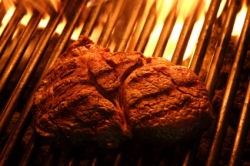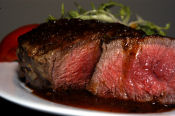|
Continued from Page 2
Preparation
 Beef should be brought to room temperature before placing on the grill. So, a couple of hours before you plan to cook, take the steaks out of the 'fridge and trim all the excess fat. (I render this down for various uses, one of which being fire starter.) Placing the meat on a thick aluminum or copper pan or cookie sheet will speed up the warming process by conducting the cold away more speedily. Cover lightly with plastic wrap but do not make an air tight seal. Beef should be brought to room temperature before placing on the grill. So, a couple of hours before you plan to cook, take the steaks out of the 'fridge and trim all the excess fat. (I render this down for various uses, one of which being fire starter.) Placing the meat on a thick aluminum or copper pan or cookie sheet will speed up the warming process by conducting the cold away more speedily. Cover lightly with plastic wrap but do not make an air tight seal.
I prefer to put no seasonings on steak before it is cooked. For my palate, the pristine flavor of pure steak properly grilled is hard to improve upon. However, for those who would like to baste or add flavors, a recipe is included at the end.
Readying the Grill
 Whether broiling (grilling) on a gas grill or over charcoal, the grill must be heated to the proper temperature. There are many theories on the proper grilling of a steak. Mine has been developed over years of experimentation, practice and tasting. My technique calls for very high temperatures 600°-700°. For those who test the temperature by holding their hand close to the grill and counting, at 700°, you should be able to count to only 1 in Roman numerals, "I!!!" Whether broiling (grilling) on a gas grill or over charcoal, the grill must be heated to the proper temperature. There are many theories on the proper grilling of a steak. Mine has been developed over years of experimentation, practice and tasting. My technique calls for very high temperatures 600°-700°. For those who test the temperature by holding their hand close to the grill and counting, at 700°, you should be able to count to only 1 in Roman numerals, "I!!!"
In order to properly broil a good steak, gas grills must produce at least 30M British Thermal Units (BTUs). Fire up the gas grill on the maximum setting and close the lid. It will take from 10-20 minutes to reach proper temperature. Charcoalers, fire up 20-25 minutes with 5 lbs of good quality, hardwood charcoal. When covered with gray ash or glowing. spread the coals evenly. When the coals are spread, meat grill should be not more than 5" above the coals.
 When the grill is right, wipe the steaks dry, and place the steaks carefully and firmly upon the grill. Then leave them alone. Do not touch them, talk to them or worry them in any way. Steaks know when they need to be turned and will show you. When a steak meets the proper grill, they seize each other with the intensity of a pair of newlyweds. At the proper time, they will turn loose. Flip them over with a spatula, not a fork. They will grab again. When they turn loose the second time, the honeymoon is over and it's time to get on with business. When the grill is right, wipe the steaks dry, and place the steaks carefully and firmly upon the grill. Then leave them alone. Do not touch them, talk to them or worry them in any way. Steaks know when they need to be turned and will show you. When a steak meets the proper grill, they seize each other with the intensity of a pair of newlyweds. At the proper time, they will turn loose. Flip them over with a spatula, not a fork. They will grab again. When they turn loose the second time, the honeymoon is over and it's time to get on with business.
Depending upon the thickness of the steak, its temperature before placing on the grill and the mass and intensity of the coals or, in the case of gas grills, heat collecting plates, the steak is well on its way. You may test for doneness with your finger. Press firmly into the center of a steak. Soft is very rare - 125°, barely discernible resistance is rare - 130°, definite resistance is medium rare -140°, firming up medium -150°. I do not know how to test for well done.
Steaks thicker than 1 1/2" may require another flip or two. A 3 incher will require several turns. Do not let it burn. Move it aside or raise the grill if required. A thick steak will continue to cook after removed from the heat. Do not over cook. You can always put it back on the grill to cook it more. You can never uncook it.
If it was properly trimmed of fat, the steak will not cause flameups. If flames appear, move the steak out of the flames until they subside or close the lid and shut off the incoming air. A properly cooked steak has dark brown stripes where it was in contact with the grill. It will have no part charred or blackened.
 Immediately remove to a warm, not hot, plate and allow to sit for 5 minutes. All the other food should be ready and waiting for the steak. Transfer to a cutting board to serve at the table. Slice diagonal across the steak and at a slight angle from vertical and serve. Guests may add salt and freshly ground black pepper as desired. Immediately remove to a warm, not hot, plate and allow to sit for 5 minutes. All the other food should be ready and waiting for the steak. Transfer to a cutting board to serve at the table. Slice diagonal across the steak and at a slight angle from vertical and serve. Guests may add salt and freshly ground black pepper as desired.
A classic broiled steak. A plump baked potato with sour cream and chives, steamed broccoli and carrots, a crisp mixed green salad with vinaigrette and a solid home made bread need only a robust wine to become a perfect accompaniment.
Continued on Page 4

Smoky's 5th basic position for really great barbecue'n.
'According to Smoky' is © by C. Clark Hale
who is solely responsible for its content. Comments
should be addresses to cchale@bellsouth.net
|